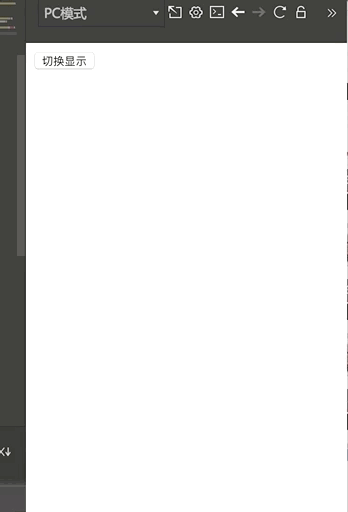What is the instruction to hide elements in vue
The command to hide elements in vue is "v-show". The v-show instruction determines whether an element is displayed or hidden based on the true or false value of the expression. The syntax is "v-show="expression"". The v-show instruction controls the display and hiding state of the element by changing the CSS display attribute of the element. The content of the expression following the instruction will eventually be parsed into a Boolean value. When the value is true (true), the element is displayed, and when the value is false (false) ) when the element is hidden.

The operating environment of this tutorial: windows7 system, vue3 version, DELL G3 computer.
Vue.js provides a v-show directive, which determines whether to display or hide an element based on the true or false value of the following expression.
The v-show command controls the display and hidden state of the element by changing the display attribute of the element's css.
v-show instruction introduction
The v-show instruction needs to be followed by a Boolean variable or Boolean expression. When the value is true Shows the element when the value is false and hides the element when the value is false.
<标签 v-show="true/false"></标签> <!--true:显示 false:隐藏-->
Example:
<div id="app">
<p v-show="flag == '显示'">Vue 课程</p>
</div><script>
var app = new Vue({
el: '#app',
data: {
flag: '隐藏'
}
});
</script>When the flag is set to 'hide', "Vue Course" will not be displayed; when the flag is set to 'show', "Vue Course" will be displayed Vue Courses".
In fact, when the flag is set to 'hidden', the css attribute display of the p element is set to none, so the element is hidden.
The rendered code is as follows:
<p style="display: none;">Vue 课程</p>
v-show code example
The following are html and js code examples
<!DOCTYPE html>
<html>
<head>
<meta charset="utf-8">
<meta name="viewport" content="width=device-width,initial-scale=1.0">
<title>v-show指令</title>
</head>
<body>
<div id="app">
<input type="button" value="切换显示" @click="changeIsShow" />
<p v-show="isShow">不装了,我摊牌了,没错你要找的就是我</p>
</div>
<script src="https://cdn.jsdelivr.net/npm/vue/dist/vue.js"></script>
<script>
var app = new Vue({
el:"#app",
data:{
isShow:false
},
methods:{
changeIsShow(){
this.isShow = !this.isShow
}
}
})
</script>
</body>
</html>The code after rendering is as follows
<p style="display: none;">不装了,我摊牌了,没错你要找的就是我</p>
The running result of the code is as follows:

Summary
The function of the v-show command is to switch the display state of the element based on the true or false value
The principle is to modify the element CSS property (display) determines whether to display or hide
The content following the directive will eventually be parsed into a Boolean value
The value is true (true ) when the element is displayed, and when the value is false (false), the element is hidden
After the data changes, the display status of the corresponding element will also be updated synchronously
[Related recommendations: vuejs video tutorial, web front-end development]
The above is the detailed content of What is the instruction to hide elements in vue. For more information, please follow other related articles on the PHP Chinese website!

Hot AI Tools

Undresser.AI Undress
AI-powered app for creating realistic nude photos

AI Clothes Remover
Online AI tool for removing clothes from photos.

Undress AI Tool
Undress images for free

Clothoff.io
AI clothes remover

AI Hentai Generator
Generate AI Hentai for free.

Hot Article

Hot Tools

Notepad++7.3.1
Easy-to-use and free code editor

SublimeText3 Chinese version
Chinese version, very easy to use

Zend Studio 13.0.1
Powerful PHP integrated development environment

Dreamweaver CS6
Visual web development tools

SublimeText3 Mac version
God-level code editing software (SublimeText3)

Hot Topics
 How to use echarts in vue
May 09, 2024 pm 04:24 PM
How to use echarts in vue
May 09, 2024 pm 04:24 PM
Using ECharts in Vue makes it easy to add data visualization capabilities to your application. Specific steps include: installing ECharts and Vue ECharts packages, introducing ECharts, creating chart components, configuring options, using chart components, making charts responsive to Vue data, adding interactive features, and using advanced usage.
 The role of export default in vue
May 09, 2024 pm 06:48 PM
The role of export default in vue
May 09, 2024 pm 06:48 PM
Question: What is the role of export default in Vue? Detailed description: export default defines the default export of the component. When importing, components are automatically imported. Simplify the import process, improve clarity and prevent conflicts. Commonly used for exporting individual components, using both named and default exports, and registering global components.
 How to use map function in vue
May 09, 2024 pm 06:54 PM
How to use map function in vue
May 09, 2024 pm 06:54 PM
The Vue.js map function is a built-in higher-order function that creates a new array where each element is the transformed result of each element in the original array. The syntax is map(callbackFn), where callbackFn receives each element in the array as the first argument, optionally the index as the second argument, and returns a value. The map function does not change the original array.
 The role of onmounted in vue
May 09, 2024 pm 02:51 PM
The role of onmounted in vue
May 09, 2024 pm 02:51 PM
onMounted is a component mounting life cycle hook in Vue. Its function is to perform initialization operations after the component is mounted to the DOM, such as obtaining references to DOM elements, setting data, sending HTTP requests, registering event listeners, etc. It is only called once when the component is mounted. If you need to perform operations after the component is updated or before it is destroyed, you can use other lifecycle hooks.
 What are hooks in vue
May 09, 2024 pm 06:33 PM
What are hooks in vue
May 09, 2024 pm 06:33 PM
Vue hooks are callback functions that perform actions on specific events or lifecycle stages. They include life cycle hooks (such as beforeCreate, mounted, beforeDestroy), event handling hooks (such as click, input, keydown) and custom hooks. Hooks enhance component control, respond to component life cycles, handle user interactions and improve component reusability. To use hooks, just define the hook function, execute the logic and return an optional value.
 What scenarios can event modifiers in vue be used for?
May 09, 2024 pm 02:33 PM
What scenarios can event modifiers in vue be used for?
May 09, 2024 pm 02:33 PM
Vue.js event modifiers are used to add specific behaviors, including: preventing default behavior (.prevent) stopping event bubbling (.stop) one-time event (.once) capturing event (.capture) passive event listening (.passive) Adaptive modifier (.self)Key modifier (.key)
 Promise usage in vue
May 09, 2024 pm 03:27 PM
Promise usage in vue
May 09, 2024 pm 03:27 PM
Promise can be used to handle asynchronous operations in Vue.js. The steps include: creating a Promise object, performing an asynchronous operation and calling resolve or reject based on the result, and processing the Promise result (use .then() to handle success, .catch() to handle errors) . Advantages of Promises include readability, ease of debugging, and composability.
 Which one is executed first, created or mounted in vue?
May 09, 2024 pm 02:00 PM
Which one is executed first, created or mounted in vue?
May 09, 2024 pm 02:00 PM
In the Vue life cycle, the created hook is executed before mounted. The created hook is used to perform DOM-free operations when the component is instantiated, while the mounted hook is used to perform DOM-related operations after the component is mounted.






